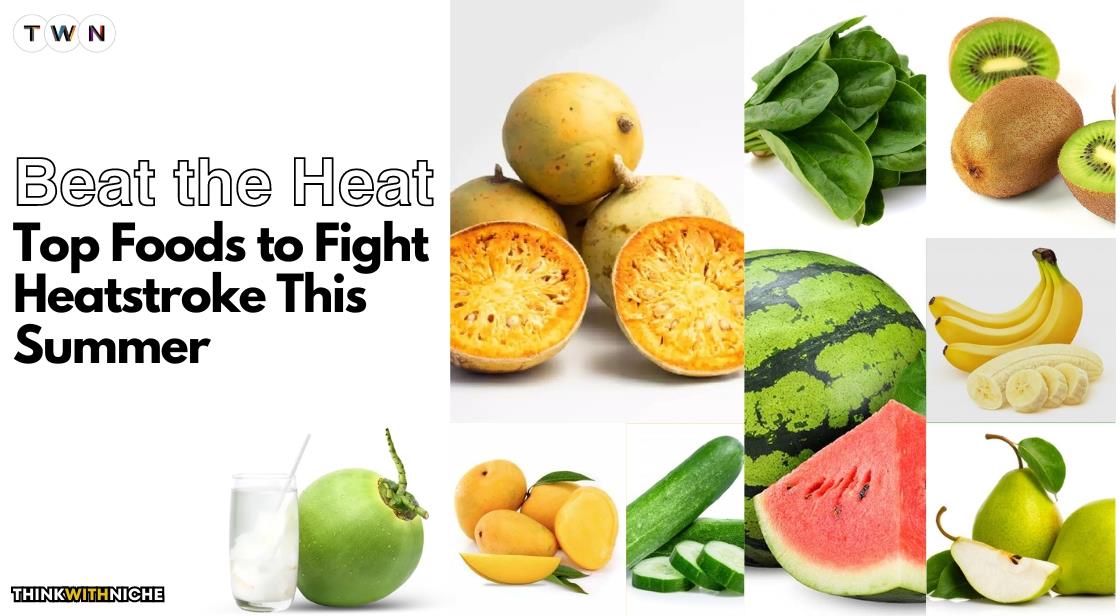Top Foods to Fight Heatstroke This Summer: Beat the Heat

Blog Post
With temperatures rising steadily each summer, the threat of heatstroke looms ever larger. Heatstroke, a serious condition resulting from prolonged exposure to high temperatures, poses significant health risks, including organ damage and even death if left untreated. While staying hydrated is paramount, adopting a strategic approach to your diet can be a powerful ally in the fight against heatstroke.
As we navigate the sweltering heat of the summer months, it's essential to arm ourselves with the right foods to keep our bodies cool, hydrated, and resilient.
Recent studies emphasize the importance of dietary choices in mitigating the risk of heatstroke. Hydrating fruits like watermelon, cucumber, and cantaloupe have emerged as front-runners in maintaining fluid balance and preventing dehydration during hot weather.
These fruits not only offer a high water content but also provide essential electrolytes like potassium and magnesium, vital for muscle function and overall well-being. Additionally, lesser-known options like wood apple (bael) and kiwi boast unique properties that aid in digestion and replenish electrolytes, further bolstering the body's defenses against heat-related illnesses.
Moreover, electrolyte-rich foods such as coconut water, bananas, and spinach play a crucial role in restoring the body's electrolyte balance, which can be depleted through excessive sweating. By incorporating these foods into our diets, we can ensure optimal hydration and reduce the risk of electrolyte imbalances, which are common precursors to heatstroke.
Furthermore, foods with a natural "cooling" effect, like yogurt and mint, offer a refreshing respite from the heat while providing additional health benefits. These cooling companions not only soothe the palate but also contribute to overall well-being, making them invaluable additions to a summer diet aimed at combating heatstroke.
In this article, we'll delve deeper into the science behind these heat-fighting foods and explore creative ways to incorporate them into your summer meals. By harnessing the power of nutrition, we can equip ourselves with the tools necessary to beat the heat and enjoy a safe, healthy, and vibrant summer season.
Essential Foods to Prevent Heatstroke: Beat the Summer Heat
As summer temperatures soar, the risk of heatstroke rises. This serious condition occurs when the body overheats and can't cool itself down. While staying hydrated is crucial, incorporating specific foods into your diet can also significantly enhance your body's ability to combat heatstroke. This article explores the top contenders to include in your summer meals, ensuring you stay cool, energized, and safe throughout the season.
Hydration Heroes: Foods Packed with Water
When battling heat, water is your best friend. But did you know some foods are nature's water bombs? These hydrating heroes top the list:
1. Watermelon: Nature's Refreshing Powerhouse (92% Water)
-
Hydration Hero: Watermelon takes the crown for water content, boasting a staggering 92%. This makes it an ideal choice for replenishing fluids lost through sweating during hot days. Studies suggest that consuming water-rich fruits like watermelon can effectively contribute to daily hydration needs.
-
Electrolyte Replenishment: Beyond pure water, watermelon offers a small amount of electrolytes like potassium and magnesium, which are crucial for maintaining proper muscle function and nerve transmission. While not a sole source of electrolytes, watermelon can be a helpful contributor, especially when combined with a balanced diet.
-
Lycopene Power: Watermelon is a rich source of lycopene, a powerful antioxidant that protects cells from damage and may offer various health benefits, including reducing the risk of heart disease and certain cancers.
Example: Enjoy chilled watermelon slices as a refreshing snack, or blend them into a hydrating smoothie with a squeeze of lime and a touch of mint for a flavorful summer beverage.
2. Cucumber: The Cool and Crisp Superstar (96% Water)
-
Ultimate Hydration: With a remarkable 96% water content, cucumber reigns supreme as the most hydrating fruit (technically a vegetable) on this list. It's a fantastic choice for staying cool and replenishing fluids, especially for those who may not enjoy plain water on its own.
-
Low in Calories and Packed with Nutrients: While low in calories, cucumber offers essential vitamins and minerals like vitamin K, important for blood clotting, and potassium, which helps regulate blood pressure.
-
Soothing and Cooling Effect: The high water content and cooling sensation of cucumber make it a popular ingredient in skincare products. Consuming cucumber may also provide a similar internal cooling effect, although more research is needed to confirm this definitively.
Example: Add sliced cucumbers to salads, sandwiches, or simply enjoy them with a sprinkle of salt and pepper for a light and refreshing snack.
3. Cantaloupe: A Delightful Blend of Hydration and Nutrients (90% Water)
-
Hydration and Sweet Satisfaction: Cantaloupe offers a delightful balance of hydration (around 90% water content) and sweetness, making it a satisfying summer treat. Similar to watermelon, it can contribute to daily fluid needs while providing a refreshing and flavorful option.
-
Vitamin A Powerhouse: Cantaloupe is an excellent source of vitamin A, essential for healthy vision, immune function, and cell growth.
-
Potassium for Overall Well-being: Like its melon cousins, cantaloupe contains potassium, a vital mineral that supports healthy blood pressure and muscle function.
Example: Dice cantaloupe into bite-sized pieces for a healthy and refreshing fruit salad. Alternatively, pair it with a dollop of yogurt or cottage cheese for a balanced and protein-rich snack.
4. Wood Apple (Bael): Nature's Digestive Champion
-
Unique Properties: The wood apple, also known as bael, is a native fruit of India and Southeast Asia with a hard, woody shell and a sticky, fibrous interior. While not as widely known as other summer fruits, it boasts a unique set of health benefits.
-
Combats Digestive Troubles: Wood apple has been traditionally used in Ayurveda to treat various digestive issues, particularly those exacerbated by hot weather. Studies suggest its tannins and phenolic compounds possess anti-inflammatory and antibacterial properties, potentially aiding in relieving dysentery and diarrhea.
-
Fiber Powerhouse for Gut Health: Wood apple is a rich source of dietary fiber, crucial for maintaining a healthy digestive system. Fiber promotes regularity, prevents constipation, and promotes a healthy gut microbiome. This is especially beneficial during summer when irregular bowel movements can be a concern.
-
Immunity Booster: Wood apple is a good source of vitamin C, a potent antioxidant that strengthens the immune system. A robust immune system is essential throughout the year, but especially during the summer months when exposure to heat and humidity can increase susceptibility to infections.
5. Kiwi: The Electrolyte Powerhouse
-
Hydration Hero: Kiwis are not just bursting with flavor; they're also packed with water (around 84%). This makes them a fantastic choice for staying hydrated during the hot summer months.
-
Electrolyte Champion: Beyond water, kiwis are a treasure trove of essential electrolytes, particularly potassium. The Institute of Medicine highlights the importance of potassium in maintaining proper hydration levels and electrolyte balance. Electrolytes play a crucial role in muscle function and nerve transmission. Depletion due to sweating during hot weather can lead to fatigue, muscle cramps, and even heatstroke.
-
Vitamin C Bonanza: Similar to wood apple, kiwis are rich in vitamin C, an antioxidant that strengthens the immune system and helps the body fight off infections [6].
6. Pear: The Sweet and Soluble Savior
-
Hydration and Fiber: Pears are another fantastic summer fruit with a high water content (around 84%). This contributes to staying hydrated and keeping cool during hot weather.
-
Soluble Fiber for Digestion: Pears are a good source of soluble fiber, a type of fiber that absorbs water and forms a gel-like substance in the digestive tract. This promotes smooth digestion, prevents constipation, and keeps you feeling fuller for longer.
-
Potential Benefits for Heatstroke: While research is ongoing, some studies suggest that soluble fiber may play a role in regulating body temperature [9]. This, combined with the hydrating properties of pears, could offer additional benefits in preventing heatstroke.
Electrolyte Powerhouses: Replenishing Essential Minerals
Electrolytes are minerals that help regulate various bodily functions, including muscle function and fluid balance. Sweating depletes electrolytes, so consider these summer dietary staples:
7. Coconut Water: Nature's Sports Drink (Electrolytes & Hydration)
-
Natural Electrolyte Replenishment: Coconut water has earned its reputation as a "natural sports drink" for a reason. Unlike sugary commercial beverages, it's packed with essential electrolytes, including potassium, sodium, and magnesium. These minerals play a vital role in maintaining proper hydration, muscle function, and nerve transmission [2].
-
Hydration Hero: Beyond electrolytes, coconut water boasts a high water content (around 95%). This makes it an excellent choice for rehydrating after sweating or physical activity. Studies suggest coconut water may even be more effective than plain water for rehydration in certain scenarios.
-
Lower in Sugar: Compared to sugary sports drinks, coconut water offers a naturally sweet and refreshing flavor with a lower sugar content [5]. This makes it a healthier choice for those watching their sugar intake.
Example: Enjoy chilled coconut water after a workout, on a hot day, or as a refreshing midday beverage.
8. Bananas: The Energy-Boosting Electrolyte Powerhouse (Potassium & Carbs)
-
Potassium Champion: Bananas are a classic and convenient source of potassium, a crucial electrolyte for regulating muscle function and nerve impulses [6]. During hot weather, sweating can deplete potassium levels, leading to muscle cramps and fatigue. Bananas help replenish these lost electrolytes, keeping you feeling energized.
-
Sustained Energy: Beyond electrolytes, bananas offer a good source of carbohydrates, the body's primary source of energy. These carbohydrates provide sustained energy throughout the day, especially beneficial during hot weather when physical activity can feel more draining.
-
Portable and Convenient: Unlike coconut water, which can be more perishable, bananas are a highly portable and convenient snack option.
Example: Pack a banana for a pre-workout snack, post-workout recovery, or simply enjoy it as a mid-morning pick-me-up.
9. Spinach: Don't Underestimate the Leafy Green Powerhouse (Potassium & Magnesium)
-
Electrolyte Duo: Spinach, often relegated to salads, packs a powerful punch when it comes to electrolytes. It's rich in both potassium and magnesium, crucial minerals for maintaining proper hydration, muscle function, and overall well-being.
-
Versatile and Nutrient-Rich: Beyond electrolytes, spinach is a powerhouse of other essential nutrients, including vitamins A, C, and K, as well as iron and folate [8]. This makes it a valuable addition to any diet, not just during the summer months.
-
Creative Culinary Options: Spinach can be enjoyed in various ways beyond salads. Blend it into smoothies, add it to stir-fries or omelets, or even try incorporating it into baked goods for a hidden dose of nutrients.
Example: Add a handful of fresh spinach to your morning smoothie for a refreshing and electrolyte-rich breakfast. Wilt spinach into your next omelet or stir-fry for a quick and nutritious meal.
Remember: While these options provide a natural source of electrolytes, it's still crucial to maintain adequate water intake throughout the day, especially during hot weather and physical activity.
10. Mango: A Tropical Treasure Trove of Vitamins and Minerals
-
A Multivitamin Powerhouse: Mango lives up to its title as the "king of fruits" with its exceptional nutrient content. It's not just delicious; it's a powerhouse of over 20 essential vitamins and minerals.
-
Vitamin C Champion: One standout feature is its exceptional vitamin C content. A single serving (¾ cup) provides a staggering 50% of your daily vitamin C needs . Vitamin C is a potent antioxidant crucial for immune function, collagen production (important for healthy skin), and iron absorption.
-
Visionary Benefits: Mango also boasts a good amount of vitamin A, contributing to 8% of your daily needs. Vitamin A plays a vital role in maintaining healthy vision, especially night vision .
-
B Vitamins for Energy and Metabolism: Don't forget about the B vitamins! Mango offers vitamin B6, contributing to 8% of your daily requirement. B vitamins play a crucial role in energy production, metabolism, and nervous system function.
-
Fiber for Gut Health: Mango is a good source of dietary fiber, essential for digestive health and promoting feelings of fullness.
-
Additional Minerals: Mango provides essential minerals like iron, potassium, magnesium, and folate, all contributing to overall well-being.
11. Muskmelon: A Hydrating Hero Packed with Electrolytes
-
Hydration Hero: Muskmelon (also known as cantaloupe or honeydew) reigns supreme when it comes to hydration. With a whopping 90% water content, it's a fantastic choice for staying cool and replenishing fluids lost through sweating during hot weather.
-
Electrolyte Powerhouse: Beyond hydration, muskmelon offers a good amount of electrolytes, particularly potassium. Electrolytes are essential minerals that help regulate muscle function, nerve transmission, and blood pressure [8]. This makes muskmelon a valuable choice for athletes and anyone engaging in physical activity.
-
Vitamin C for Immunity: Similar to mango, muskmelon contains vitamin C, although in a slightly lower amount. This essential vitamin still contributes to a healthy immune system and overall well-being].
-
Fiber for Digestion: Muskmelon offers a moderate amount of dietary fiber, promoting gut health and regularity.
Cooling Companions: Foods with a Cooling Effect
Some foods are believed to have a natural "cooling" effect on the body. While the science behind this is still evolving, including these options in your diet may provide additional benefits:
12. Yogurt: A Cool and Probiotic Powerhouse (Cooling Effect & Electrolytes)
-
Possible Cooling Effect: Plain yogurt, particularly chilled yogurt, may provide a mild cooling sensation upon consumption. The exact mechanism behind this isn't fully understood, but it could be related to the yogurt's temperature and its effect on body temperature receptors in the mouth and throat .
-
Electrolyte Replenishment: Beyond a potential cooling effect, yogurt offers a good source of electrolytes, including potassium and calcium . These minerals are crucial for maintaining proper hydration and muscle function, especially important during hot weather when sweating can lead to electrolyte depletion.
-
Probiotic Power: Yogurt is a well-known source of probiotics, live bacteria that contribute to a healthy gut microbiome. A healthy gut microbiome may play a role in overall well-being, potentially including immune function, which can be helpful during hot weather.
Example: Enjoy chilled plain yogurt with a sprinkle of berries or a drizzle of honey for a refreshing and nutritious snack. Yogurt can also be incorporated into smoothies or used as a base for dips and raitas.
Also Read: Top Livestock Farming Businesses with High Growth Potential in 2023
13. Mint: The Refreshing Herb with a Cooling Sensation (Cooling Sensation)
-
Menthol's Cooling Magic: Mint leaves are widely known for their refreshing and cooling properties. This sensation is primarily due to the presence of menthol, a compound that activates cold receptors in the mouth and throat. While it doesn't necessarily lower your body temperature, it creates a perception of coolness.
-
Versatility and Flavor: Beyond the cooling effect, mint offers a delightful flavor that can enhance various dishes and beverages. Fresh mint leaves can be added to salads, infused in water for a refreshing drink, or blended into smoothies.
Example: Muddle fresh mint leaves in a glass of iced water with a squeeze of lemon for a homemade and invigorating cooler. Add chopped mint to a fruit salad or incorporate it into a chilled gazpacho soup for a burst of flavor and a cooling sensation.
Remember: While these options may offer a delightful cooling effect, it's important to note that the science behind it is still evolving. Maintaining proper hydration with water remains the most crucial strategy for combating summer heat. However, incorporating these "cooling companions" into your diet can add a refreshing touch and provide additional health benefits.
Further Exploration: Researchers are actively exploring the potential connection between food and internal body temperature regulation. As research progresses, we may gain a clearer understanding of the role specific foods play in this area.
Conclusion:
By incorporating these top foods into your summer diet, you can significantly enhance your body's ability to combat the heat and prevent heatstroke. Remember, staying hydrated with water remains paramount. However, these dietary choices provide an additional layer of defense, keeping you cool, energized, and allowing you to enjoy the summer season to the fullest.
You May Like
EDITOR’S CHOICE












